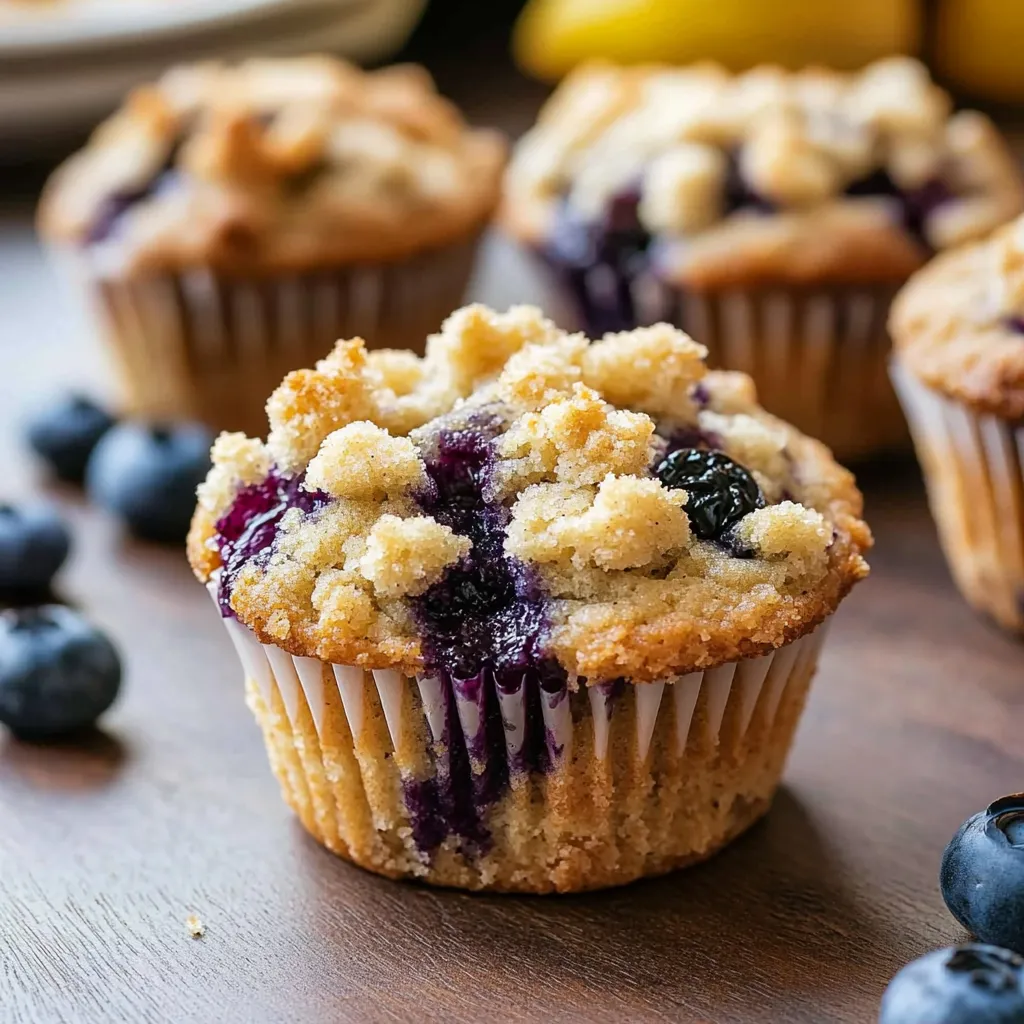 Pin it
Pin it
These blueberry crumb muffins bring bakery-quality indulgence right to your kitchen. The tender, vanilla-scented batter cradles juicy blueberries while a cinnamon-spiced streusel topping creates the perfect textural contrast. What makes these muffins truly special is the brightness from fresh citrus zest that cuts through the sweetness and elevates the entire experience. I've perfected this recipe over dozens of batches to achieve those gloriously domed tops and moist centers you'd expect from a professional bakery.
I've made these muffins for countless weekend brunches, and they're always the first thing to disappear. My family particularly loves them warm from the oven with a pat of butter melting into the crumbly topping.
Essential Ingredients
- All-Purpose Flour: Creates the perfect structure; measure by spooning into cups and leveling for accuracy. Too much flour makes tough muffins.
- Eggs: Room temperature eggs incorporate more evenly into the batter, giving better rise and texture.
- Buttermilk: The acidity creates tenderness while adding subtle tang. Real cultured buttermilk gives better results than substitutes.
- Blueberries: Look for firm, plump berries without soft spots. Wild berries offer more intense flavor, though they're smaller.
- Baking Powder: Your leavening agent; check expiration dates as old baking powder won't give proper rise.
- Vanilla Extract: Pure extract (not imitation) provides depth of flavor that complements the berries.
- Citrus Zest: Fresh lemon and orange zest cuts through sweetness with bright notes that wake up the flavor.
- Butter: Use unsalted so you can control the salt level. Quality butter with higher fat content improves flavor.
- Sugar: Regular granulated sugar provides the right sweetness and helps create the tender crumb.
- Salt: Don't skip it! Fine sea salt enhances all other flavors without making muffins taste salty.
Step-by-Step Instructions
- Step 1: Preparing the Streusel Topping
- Start with cold butter cut into small cubes—this creates those delightful chunky crumbs everyone fights over. Whisk together sugar, flour, and cinnamon in a small bowl, then work the butter in with your fingertips until you have a mixture resembling coarse sand with some larger pieces. The variation in crumb size creates wonderful texture. Refrigerate while making the batter to keep the butter firm.
- Step 2: Setting Up
- Preheat your oven to exactly 375°F—use an oven thermometer for accuracy as most ovens run hot or cold. Line a standard 12-cup muffin tin with quality paper liners (the thicker ones prevent sticking). Position your oven rack in the center position for even heat distribution.
- Step 3: Mixing Dry Ingredients
- In a large bowl, thoroughly whisk together the flour, sugar, baking powder, salt, and citrus zests. The whisking not only combines ingredients but also aerates the flour, contributing to a lighter texture. Make a well in the center to receive the wet ingredients.
- Step 4: Combining Wet Ingredients
- In a separate bowl, whisk together melted (but not hot) butter, room-temperature egg, buttermilk, and vanilla until smooth and well-incorporated. The mixture might look slightly curdled due to temperature differences—this is completely normal and won't affect your finished muffins.
- Step 5: Creating the Batter
- Pour the wet ingredients into the well of dry ingredients. Using a rubber spatula, fold everything together with broad, gentle strokes, scraping from the bottom of the bowl. Stop mixing when you still see a few streaks of flour—overmixing develops gluten, resulting in tough muffins. The batter should look lumpy and thick.
- Step 6: Adding Blueberries
- If using fresh blueberries, gently toss them with a teaspoon of flour to help them stay suspended in the batter. For frozen berries, keep them frozen until the last minute. Fold the berries into the batter with just 4-5 strokes, being careful not to crush them. Some streaks of flour are still fine at this stage.
- Step 7: Filling Muffin Cups
- Use an ice cream scoop or large cookie scoop for even portioning—filling each cup about 3/4 full. This measured approach ensures consistent baking and those perfect domed tops. Tap the pan gently on the counter once to release any large air bubbles.
- Step 8: Applying the Topping
- Remove the chilled streusel from the refrigerator and break it into pieces of varied sizes with your fingers. Generously sprinkle the topping over each muffin, gently pressing larger pieces into the batter slightly so they don't fall off during baking.
- Step 9: Baking to Perfection
- Place the muffin tin on the center rack and don't open the oven for at least 15 minutes—cold drafts can cause uneven rising. Bake for 22-25 minutes total, rotating the pan halfway through. Look for golden edges pulling away slightly from the pan, and tops that spring back when lightly touched. For absolute certainty, an internal temperature of 200°F indicates they're done.
- Step 10: Cooling Properly
- Allow muffins to rest in the pan for exactly 5 minutes—this sets the structure while allowing them to release more easily. Then transfer to a wire rack to cool completely. This critical step prevents condensation from making the bottoms soggy.
My grandmother always added orange zest to her blueberry muffins, which seemed odd to me as a child. Now I understand her wisdom—the citrus brightens everything and makes the blueberry flavor more vibrant. When my son was younger, he'd always pick off the streusel topping first, saving the bottom for last. Now that he's older, he appreciates how all the elements work together.
The Secret to Moist Muffins
The key to preventing dry, disappointing muffins lies in three crucial techniques. First, measure your flour correctly by spooning it into measuring cups rather than scooping directly from the bag, which compacts it. Second, the buttermilk's acidity breaks down gluten proteins, creating tenderness. Finally, allowing the baked muffins to rest for about two hours after baking lets the moisture redistribute evenly throughout. I discovered this last tip by accident when I had to leave a batch to cool completely before serving, and noticed they were significantly more moist and flavorful than when eaten warm.
Seasonal Variations Worth Trying
Don't feel limited to the classic recipe when seasonal produce offers wonderful opportunities for customization. In late summer, replace half the blueberries with blackberries for a more complex flavor profile. During fall, try adding a quarter cup of finely diced apple and a pinch of nutmeg to the batter. Winter citrus season brings the perfect opportunity to experiment with different zests—blood orange or Meyer lemon both create distinctive flavor notes that complement the blueberries beautifully. I've found that these seasonal adaptations keep the recipe fresh and exciting throughout the year while maintaining the beloved texture and structure.
The Importance of Proper Cooling
Never underestimate the significance of how you cool your muffins—it's not just an afterthought but a crucial step that affects texture and flavor. Initial cooling in the tin allows the structure to set without collapsing, while moving them to a rack prevents soggy bottoms from trapped steam. The two-hour waiting period before eating might test your patience, but it allows the flavors to meld and the crumb to fully develop. I've conducted side-by-side tastings with my baking group, and everyone agrees that properly cooled muffins have significantly better texture and more pronounced blueberry flavor than those eaten straight from the oven. The difference is particularly noticeable the next day, when properly cooled muffins remain moist while hastily eaten ones would have dried out.
Frequently Asked Questions
- → Can I swap frozen blueberries for fresh ones?
- Of course! Fresh or frozen both work well. If you're using frozen, don't bother thawing them first.
- → How do I avoid dense muffins?
- Don't overmix the batter—just stir until everything's combined evenly. It's fine if the batter has small lumps.
- → Is it okay to bake these ahead?
- Totally! Make them a day early and store them in an airtight container at room temperature for up to 2 days.
- → Why do I need to chill the crumb topping first?
- It keeps the crumbs firm, helping them stay chunky and bake up nicely without melting too fast.
- → What’s a quick buttermilk replacement?
- Mix 2 teaspoons of lemon juice with some milk. Let it rest for a few minutes, and you're good to go.
